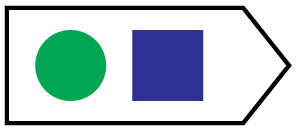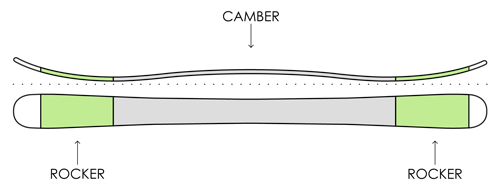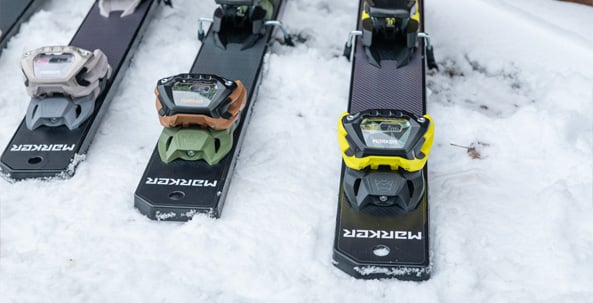Skis are your ticket to the mountains. The right setup can unlock a world of adventure, but it can be tough to narrow down which skis are right for you. In this guide, we'll explain what goes into choosing a ski, from waist width to rocker profile and beyond. Whether you're eyeing pristine groomers or dreaming of bottomless powder, there's a perfect ski for you!
Contents
What Length Should My Skis Be?

Your height and ability level provide the starting point to figure out the right ski length for you. Proper ski length is typically somewhere between your chin and the top of your head, although experienced skiers may opt for something even longer. For example, a skier that is 6’ / 183 cm tall will want to look for skis between 170 cm and 190 cm. The right length will depend on a variety of factors.
Start off by using the chart below to find your recommended ski length according to your height and ability level. Remember, this is just an initial recommendation. Other factors to consider when choosing a ski include:
– Ski Width
– Ski Rocker Profile
– Ski Turn Radius
– Terrain
Ski Size Chart
Click your ski length to shop
Should You Size Up or Down?
Within your suggested size range there are several reasons to choose a shorter or longer ski. In general, shorter skis are more nimble and easier to turn, while longer skis are more stable at speed.
Reasons to size skis shorter, closer to your chin:
- You are a beginner or intermediate skier.
- You like to make short, quick turns.
- You weigh less than average for your height.
- You ski mainly on the groomers.
- You want a ski with plenty of camber, like a carving ski.
Reasons to size skis longer, closer to the top of your head:
- You are an advanced or expert skier.
- You typically ski fast and aggressively.
- You weigh more than average for your height.
- You ski mainly on ungroomed terrain.
- You want a ski with plenty of rocker, like a powder ski.
Skier Ability Level
There are a bunch of design features that combine to make a ski more or less suited to skiers of different ability levels. These include the ski's materials, flex, shape, and dimensions. If you're shopping by ability level, look out for the following:
Beginner / Intermediate

Beginner-intermediate skis usually have a softer flex, narrower waist width, composite, foam or softer wood core, and capped construction. These skis are easy to turn and very forgiving if your technique is less than perfect.
A little rocker in the tip and tail helps these skis feel less catchy as well as aiding turn initiation.
Intermediate / Advanced

Compared to beginner-intermediate skis, these skis may be wider, with a stronger wood core and sandwich sidewall construction.
Depending on the type of ski, intermediate-advanced level skis may have full camber, rocker, or some combination of the two.
Advanced / Expert

Advanced to expert skis are for the more aggressive and skilled skiers. You will usually find powerful wood cores with additional layers of metal, carbon or flax to improve high-speed performance. These skis may be stiffer and more challenging to control at slower speeds.
Expert level carving, park, all-mountain and powder skis come with a wide variety of rocker profiles.
Ski Waist Width

Waist width, measured at the narrowest point of the ski, is one of the most important specs after length. It has a large influence on how easy the ski is to turn, and how it will handle powder and ungroomed snow.
Narrower waist widths shine in firm snow conditions. They provide quick edge to edge performance during turns, making them a great choice for carving on groomed terrain.
Wider waist widths are ideal for ungroomed terrain and fresh snow. The larger surface area provides better float in powder and stability in choppy snow.
Choosing a ski somewhere in the middle – around 100mm underfoot – can deliver the best of both worlds for optimal all mountain performance.
Shop Skis by Waist Width
Ski Rocker Profile
Ski rocker profile refers to the shape of a ski when viewed from the side, specifically how the ski curves along its length. This design feature has a huge impact on how the ski performs in different snow conditions and terrain. Manufacturers offer a range of profiles, each enhancing performance in different ways. Here are the most common rocker profiles to look out for:
Camber

A traditional ski profile where the center of the ski arches upward when unweighted, with contact points at the tip and tail.
Camber provides excellent precision, stability, and edge-hold on groomed terrain, as well as providing energy and pop for freestyle riding. This profile is preferred by ski racers and high level park riders.
Rocker / Camber

A hybrid profile combining rocker in the tip with camber underfoot. This profile places the front contact point further back from the tip, while the rear contact point remains close to the tail.
Offers easier turn initiation and improved float in powder while maintaining the precision and energy of traditional camber.
Rocker / Camber / Rocker

A hybrid featuring rocker at the tip and tail with camber underfoot. The contact points at both tip and tail are shifted towards center of the ski.
The addition of tail rocker makes it easier to release the ski from a turn, providing a more nimble and playful feel while maintaining float, edge-hold, and stability for all-mountain performance.
Today, a majority of skis feature some variation on this profile, making it the most popular and versatile choice.
Ski Turn Radius

Turn radius is the shape of a ski determined by its tip, waist, and tail width, usually expressed in meters. The narrower the waist width is in relation to the tip and tail, the deeper the sidecut and the shorter the turn radius.
A ski with a deep sidecut (short turn radius) will make quicker turns on edge, while a ski with a subtle sidecut (long turn radius) will make longer turns on edge. Generally speaking, a ski with a longer turn radius will feel more stable and composed skiing at high speed.
Terrain
It’s important to consider the type of terrain that you will be skiing most often when choosing a pair of skis. Different styles of skis will excel on different areas of the mountain. You will find that the lines between different types of skis are more and more blurred these days so that many skis fall under more than one category.
All Mountain Skis
All mountain skis are designed to handle anything you throw at them – powder, ice, groomers, trees, and everything in between. If you’re only going to own one ski to do it all, this is what you want.
All mountain skis come in a wide range of shapes and waist widths to match the specific needs of different skiers. The key is to figure out where you'll be spending the majority of your time on the mountain and what type of terrain you like to ski most.
Powder Skis
These skis are for the deep days. If you like to live for big dumps at your local resort or go on backcountry missions for the freshest of fresh, powder skis are what you need to stay afloat.
Skis in the powder category are wide (115 mm or more in the waist) and usually have some form of rocker or early rise. Some have unique shapes that optimize performance in deep snow, like swallowtails or reverse sidecuts. Many powder skis are versatile enough to handle mixed conditions and harder snow in the resort, too.
Park Skis
Park skis, often called freestyle skis, are for skiers who spend the majority of their time in the terrain park. If jumps, rails, and jibs of all kinds are your thing then check out this category.
Though park and pipe skis often have narrower waists with full camber profiles, this category can feature a variety of shapes and rocker profiles. They are built to provide plenty of energy or "pop" for freestyle maneuvers, and often incorporate park specific features like thick, durable edges, tough base material, and flexy "butter zones" in the tip and tail.
Big Mountain Skis
Big mountain skis are designed for charging big lines with high speeds and big airs. These skis vary in width from wide, powder-oriented skis to narrower, mixed condition skis for ripping the beat up headwall at your local mountain.
Skis in this category tend to be on the stiffer and heavier side, often with more rocker in the tip and less in the tail.
Carving Skis
If you love the classic feeling of laying a ski over on edge and arcing a perfect turn, carving skis are what you want. These skis have narrow waists and shorter turn radii for edge to edge speed and response on hard-pack surfaces.
Skis in this category range from burly race skis to smooth, easy turning options suitable for beginners.
Alpine Touring Skis
Also known as backcountry skis, alpine touring (AT) skis are designed for going uphill as well as down. These skis are typically lighter than skis designed for the resort to reduce fatigue on the skin track.
AT skis vary widely in style, waist width, and weight. Wider heavier versions are typically used for deep snow touring in winter, while skinnier, lighter skis are often used for spring/summer touring and skimo racing.
Testing & Renting Skis & Snowboards
It’s easy to obsess over every measurement and material of different ski and snowboard models when looking at them on a computer screen, but there is absolutely no substitute for some real-time on the snow. So, once you’ve narrowed down the candidates and you’re ready to choose your next model, it’s time to get on snow. Renting or demoing skis and snowboards is the only true way to get a feel for how they ride, and if they suit you.
Check out evoRentals, our industry-leading ski and snowboard rental experience at our locations, which offers a wide variety of the latest models.

evo Staff
A collaboration by evo's in-house experts.
The evo employees who collaborated to produce this guide are more than just a group of keyboard warriors, they are experts in their field. Leaning on their knowledge, expertise, and everyday stoke, we hope to provide valuable insights on choosing the right skis for you.



